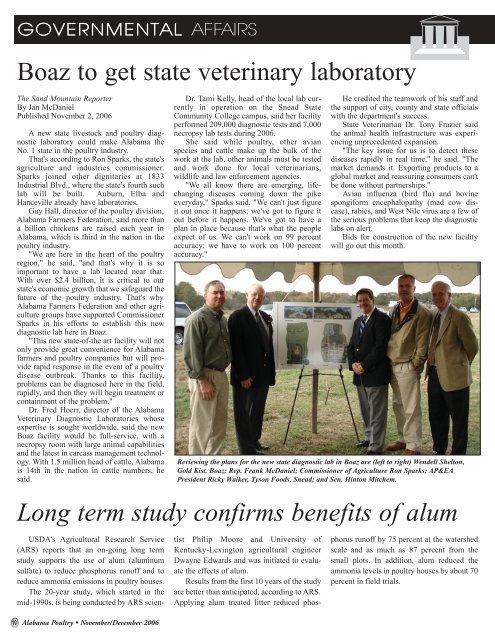THE OFFICIAL MAGAZINE OF THE ALABAMA POULTRY & EGG ...
THE OFFICIAL MAGAZINE OF THE ALABAMA POULTRY & EGG ...
THE OFFICIAL MAGAZINE OF THE ALABAMA POULTRY & EGG ...
Create successful ePaper yourself
Turn your PDF publications into a flip-book with our unique Google optimized e-Paper software.
GOVERNMENTAL AFFAIRS �<br />
Boaz to get state veterinary laboratory<br />
The Sand Mountain Reporter<br />
By Jan McDaniel<br />
Published November 2, 2006<br />
A new state livestock and poultry diagnostic<br />
laboratory could make Alabama the<br />
No. 1 state in the poultry industry.<br />
That's according to Ron Sparks, the state's<br />
agriculture and industries commissioner.<br />
Sparks joined other dignitaries at 1833<br />
Industrial Blvd., where the state's fourth such<br />
lab will be built. Auburn, Elba and<br />
Hanceville already have laboratories.<br />
Guy Hall, director of the poultry division,<br />
Alabama Farmers Federation, said more than<br />
a billion chickens are raised each year in<br />
Alabama, which is third in the nation in the<br />
poultry industry.<br />
"We are here in the heart of the poultry<br />
region," he said, "and that's why it is so<br />
important to have a lab located near that.<br />
With over $2.4 billion, it is critical to our<br />
state's economic growth that we safeguard the<br />
future of the poultry industry. That's why<br />
Alabama Farmers Federation and other agriculture<br />
groups have supported Commissioner<br />
Sparks in his efforts to establish this new<br />
diagnostic lab here in Boaz.<br />
"This new state-of-the art facility will not<br />
only provide great convenience for Alabama<br />
farmers and poultry companies but will provide<br />
rapid response in the event of a poultry<br />
disease outbreak. Thanks to this facility,<br />
problems can be diagnosed here in the field,<br />
rapidly, and then they will begin treatment or<br />
containment of the problem."<br />
Dr. Fred Hoerr, director of the Alabama<br />
Veterinary Diagnostic Laboratories whose<br />
expertise is sought worldwide, said the new<br />
Boaz facility would be full-service, with a<br />
necropsy room with large animal capabilities<br />
and the latest in carcass management technology.<br />
With 1.5 million head of cattle, Alabama<br />
is 14th in the nation in cattle numbers, he<br />
said.<br />
USDA's Agricultural Research Service<br />
(ARS) reports that an on-going long term<br />
study supports the use of alum (aluminum<br />
sulfate) to reduce phosphorus runoff and to<br />
reduce ammonia emissions in poultry houses.<br />
The 20-year study, which started in the<br />
mid-1990s, is being conducted by ARS scien-<br />
10 Alabama Poultry November/December 2006<br />
Dr. Tami Kelly, head of the local lab currently<br />
in operation on the Snead State<br />
Community College campus, said her facility<br />
performed 209,000 diagnostic tests and 7,000<br />
necropsy lab tests during 2006.<br />
She said while poultry, other avian<br />
species and cattle make up the bulk of the<br />
work at the lab, other animals must be tested<br />
and work done for local veterinarians,<br />
wildlife and law enforcement agencies.<br />
"We all know there are emerging, lifechanging<br />
diseases coming down the pike<br />
everyday," Sparks said. "We can't just figure<br />
it out once it happens; we've got to figure it<br />
out before it happens. We've got to have a<br />
plan in place because that's what the people<br />
expect of us. We can't work on 99 percent<br />
accuracy; we have to work on 100 percent<br />
accuracy."<br />
tist Philip Moore and University of<br />
Kentucky-Lexington agricultural engineer<br />
Dwayne Edwards and was initiated to evaluate<br />
the effects of alum.<br />
Results from the first 10 years of the study<br />
are better than anticipated, according to ARS.<br />
Applying alum treated litter reduced phos-<br />
He credited the teamwork of his staff and<br />
the support of city, county and state officials<br />
with the department's success.<br />
State Veterinarian Dr. Tony Frazier said<br />
the animal health infrastructure was experiencing<br />
unprecedented expansion.<br />
"The key issue for us is to detect these<br />
diseases rapidly in real time," he said. "The<br />
market demands it. Exporting products to a<br />
global market and reassuring consumers can't<br />
be done without partnerships."<br />
Avian influenza (bird flu) and bovine<br />
spongiform encephalopathy (mad cow disease),<br />
rabies, and West Nile virus are a few of<br />
the serious problems that keep the diagnostic<br />
labs on alert.<br />
Bids for construction of the new facility<br />
will go out this month.<br />
Reviewing the plans for the new state diagnostic lab in Boaz are (left to right) Wendell Shelton,<br />
Gold Kist, Boaz; Rep. Frank McDaniel; Commissioner of Agriculture Ron Sparks; AP&EA<br />
President Ricky Walker, Tyson Foods, Snead; and Sen. Hinton Mitchem.<br />
Long term study confirms benefits of alum<br />
phorus runoff by 75 percent at the watershed<br />
scale and as much as 87 percent from the<br />
small plots. In addition, alum reduced the<br />
ammonia levels in poultry houses by about 70<br />
percent in field trials.



